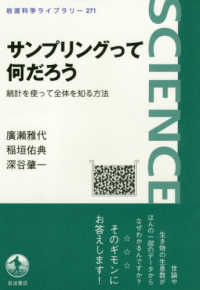- ホーム
- > 洋書
- > ドイツ書
- > Mathematics, Sciences & Technology
- > Chemistry
Full Description
An essential resource for the practical implementation of new technologies in the laboratory value chain
In Laboratory of the Future: Building the Digital Transformation, distinguished chemist Dr. Thorsten Teutenberg delivers an up-to-date discussion of digitization and automation, smart workflows, flexible laboratory automation, miniaturization and sustainability in the contemporary laboratory environment. With a strong focus on the practical implementation of the latest technologies and workflows, the book's intention is to advocate for the digital transformation.
Each chapter concludes with various insights from renowned experts in the field, encouraging readers to think critically and deepen their understanding of the presented concepts. These perspectives offer alternative interpretations, highlight the complexity of real-world implementation, and stimulate informed debate. Engaging with diverse perspectives helps readers assess the strengths and limitations of various approaches, fostering a balanced and comprehensive grasp of laboratory digitalization.
Laboratory of the Future: Building the Digital Transformation is a valuable resource for laboratory managers, scientists, digital transformation leaders, and decision-makers involved in research and development environments seeking to optimize workflows, enhance data integrity, and implement automation technologies. It offers insights into the future of lab technologies by presenting the challenges and strategies for digitizing laboratory operations and incorporating expert perspectives and practical case studies.
Contents
List of Contributors xiii
Foreword - December 2024 xv
1 The Lab of the Future 1
1.1 Presentation of the FutureLab.NRW Concept 1
1.1.1 The Inspiration 1
1.1.2 The Starting Point 1
1.1.2.1 Instrumental Analysis for Small Molecule Quantification 1
1.1.2.2 Effect-based Analysis for Identifying Relevant Compounds of Interest 3
1.1.3 The Transformation of the Lab: New Concepts for the FutureLab. Nrw 4
1.1.3.1 Instrumental Analysis for Large Molecule Quantification 4
1.1.3.2 Direct Coupling of Instrumental and Effect-based Analysis 5
1.1.3.3 Miniaturization 5
1.1.3.4 Digitalization 5
1.2 Presentation of the FutureLab.NRW Software Platform 6
1.2.1 Introductory Remarks 6
1.2.2 Overall Specifications 7
1.2.3 Inclusion of the FAIR Data Principles 8
1.3 The Center for Life Science Automation (CELISCA) - An Interview with Prof. Dr. Kerstin Thurow from the University of Rostock 8
1.3.1 Personal Introduction 8
1.3.2 CELISCA's Approach to Automation 9
1.3.3 Mobile Robots in the Lab 10
1.3.4 The Limits of Automation 12
1.3.5 The Future of Training 13
2 Electronic Laboratory Notebooks 17
2.1 Introductory Remarks - FAIR Data and the Reproduction Crisis 17
2.2 ELN Without LIMS? 17
2.2.1 A Brief and Not Comprehensive Definition of the Nature of an ELN 17
2.2.2 Some Important Functionalities of an ELN 19
2.2.2.1 Introductory Remarks 19
2.2.2.2 Metadata 19
2.2.2.3 Accessibility 19
2.2.2.4 Standardization 20
2.2.2.5 Data Protection 20
2.2.2.6 Versioning 20
2.2.2.7 Data Quality 21
2.2.2.8 Collaboration 21
2.2.2.9 Long-term Archiving 21
2.2.2.10 Data Security 21
2.2.2.11 Conclusion 22
2.3 Use-case: Digital Instrument Logs 22
2.3.1 Introductory Remarks 22
2.3.2 Implementation 22
2.4 Chemotion: Developing an Open-source Platform for Data Acquisition and Storage - An Interview with Dr. Patrick Hodapp from the Karlsruhe Institute of Technology 24
2.4.1 Personal Introduction 24
2.4.2 Motivation for Developing Chemotion 25
2.4.3 Meeting the Specific Needs of an Organic Chemistry Laboratory 26
2.4.4 Overcoming Barriers of Adoption 26
2.4.5 Improving the Quality and the Output of Publications 26
2.4.6 Long-term Maintenance of the Platform 27
2.4.7 Arguments Against Using an ELN 27
2.5 ELNs Are Dead! Long Live ELNs! - An Interview with Dr. Samantha Pearman-Kanza from the University of Southampton 28
2.5.1 Personal Introduction 28
2.5.2 Replacing Paper Notebooks 29
2.5.3 Choosing an Appropriate ELN 30
2.5.4 Data Privacy 31
2.5.5 Continuity of Platform 32
2.5.6 Further Research on ELNs - Overcoming Current Technical Limitations 32
2.5.7 Using Advanced AI Tools to Retrieve Valuable Information from the Data Lake 33
3 Digital Transformation, But How? 35
3.1 Introduction 35
3.2 Existing Problems Calling for a Digital Solution 36
3.2.1 Introductory Remarks 36
3.2.2 Stringent Standards 36
3.2.3 Manual Documentation 36
3.2.4 Data Integrity 37
3.2.5 Reproducibility 37
3.3 Challenges on the Road to a Digital Transformed Lab 38
3.3.1 Missing Guidance 38
3.3.2 Moon-shot Thinking 39
3.3.3 Legacy Devices 39
3.3.4 Heterogeneous Device Landscape 40
3.4 Digitization Versus Digital Transformation 41
3.5 Existing Approaches for Digitized Laboratory Environment 42
3.6 Methodical Approach 44
3.6.1 Introduction 44
3.6.2 Stakeholder Acquisition 44
3.6.3 Defining the Objective 46
3.6.3.1 Introduction 46
3.6.3.2 Tier One: Explorative Laboratory 46
3.6.3.3 Tier Two: Remote Controlled Laboratory 47
3.6.3.4 Tier Three: Semi-automatic Laboratory 47
3.6.3.5 Tier Four: Automatic Laboratory 47
3.6.3.6 Tier Five: AI Laboratory 47
3.6.3.7 Conclusion 47
3.6.4 Workflow Analysis 48
3.6.5 Workflow Abstraction 51
3.6.5.1 Introduction 51
3.6.5.2 Digitization of Measured Values 51
3.6.5.3 Automation 52
3.6.5.4 Process Control Commands 52
3.6.5.5 Process Control Variables 53
3.6.6 Gateway and Cybersecurity 53
3.6.7 Gateway Connector 54
3.6.8 Choosing the Middleware 55
3.6.8.1 Introduction 55
3.6.8.2 Commercial IoT Platform 55
3.6.8.3 Software Ecosystem 56
3.6.9 Choosing Network Protocols 57
3.6.10 Driver Development 58
3.6.11 IoT Server 59
3.6.12 Integrating Inter-Process Software 59
3.6.13 Workflow Implementation 59
3.6.14 Functional Integration 60
3.6.14.1 Introduction 60
3.6.14.2 Hardware Layer 60
3.6.14.3 Software Layer 61
3.7 Final Conclusion 61
3.8 Lessons Learned: An Interview with Dr. Jochen Tuerk, Head of the Cooperation Laboratory of Ruhrverband and Emschergenossenschaft / Lippeverband 62
3.8.1 Personal Introduction 62
3.8.2 Moon-shot Thinking 62
3.8.3 The Role of Digital Natives 64
3.8.4 Requirements of Guidelines 65
3.8.5 LIMS, ELN, or LES, That Is the Question 66
3.9 The Digital Transformation in the Chemical Industry - An interview with Dr. Joachim Richert from Technical University of Darmstadt 66
3.9.1 Personal Introduction 66
3.9.2 The Digital Transformation in Industry 67
3.9.3 Commitment of Users and Vendors to Achieve the Digital Transformation 68
3.9.4 Core Stakeholders 70
3.9.5 Shortcomings of Academic Research in Student Education 70
4 Communication Standards 77
4.1 Introduction to Device Communication 77
4.2 What Is a Communication Layer? 78
4.3 SiLA 2 and LADS OPC UA 79
4.3.1 Origins and Development 79
4.3.2 Communication Paradigms 79
4.4 SiLA - An Interview with Daniel Juchli from Wega Informatik AG 81
4.4.1 Personal Introduction 81
4.4.2 Plug-and-Play Connectivity 81
4.4.3 The Status Quo of SiLA 82
4.4.4 There are Many Standards - So Let's Try to Harmonize, Using a New Standard 82
4.4.5 The Chicken and Egg Problem 83
4.4.6 The Role of Open Source in Lab Automation Standards 83
4.4.7 The Future of Lab Standardization: Trends and Challenges 83
4.5 LADS - An Interview with Dr. Matthias Arnold 84
4.5.1 Personal Introduction 84
4.5.2 Why Another Standard? 85
4.5.2.1 "Plug-and-Play Connectivity" - Revisited 85
4.5.2.2 OPC UA Companion Specifications and "Machine Plug and Play" 86
4.5.2.3 "Human Versus Machine Plug and Play" - LADS OPC UA Example 87
4.5.2.4 The Role of Ontologies and Taxonomies - FAIR Data and AI Enablement 87
4.5.3 The Future Perspective of LADS 88
4.5.4 Tackling Cybersecurity Challenges 89
4.5.5 Coexistence of the Two Standards 90
4.6 Digitalization at Roche - An Interview with Tom Kissling from F. Hoffmann - La Roche Ltd. 91
4.6.1 Personal Introduction 91
4.6.2 The Role of Standardization 91
4.6.3 Money Can Buy Everything, Can't It? 91
4.6.4 The Concept of Digital Transformation at Roche 92
4.6.5 Academic Versus Industrial Research 92
4.7 Summary from the Perspective of a Device Integrator - A Brief Comment from Julian Luebke, Chief Business Officer at Labforward GmbH 92
5 Data and Data Processing Standards 95
5.1 Introduction 95
5.2 Data Standards 95
5.2.1 Introduction 95
5.2.2 The Basics of Data Standards 97
5.2.3 Use Cases for Open Data Standards 99
5.2.3.1 Introduction 99
5.2.3.2 Basic Parameters 99
5.2.3.3 Multidimensional Analytical Data 101
5.2.4 Software to Read, Write, and Process Open Data Standards 101
5.3 Data Processing 102
5.3.1 Introductory Remarks 102
5.3.2 Data Competences 105
5.3.3 Vendor Versus Open-source Processing Software 106
5.3.4 Reproducible Workflows with StreamFind 108
5.3.5 Automated Use of Results in Broader Smart Laboratory Workflows 109
5.4 An Overview About Important Data Standards: AnIML, ASM, and ADF - An Interview with Dr. Philip Wenig from Lablicate GmbH 111
5.4.1 Personal Introduction 111
5.4.2 Open-Source Versus Proprietary Software 112
5.4.3 A Brief and General Overview about AnIML, ASM, and ADF 112
5.4.4 The Future Perspective of Data Standards 113
5.5 Data Processing with a Focus on Advanced Data Analysis and Quality Assurance - An Interview with Dr. Gerrit Renner from University of Duisburg-Essen 114
5.5.1 Personal Introduction 114
5.5.2 Challenges of Data Processing with Vendor Software 115
5.5.3 Quality Assurance in Vendor and Open-source Software 116
5.5.4 Transparency in Data Processing 117
5.5.5 Opportunities from Advances in Data Science 118
6 Smart Digital Workflows 121
6.1 General Introduction 121
6.2 Temperature Monitoring 122
6.2.1 Introduction 122
6.2.2 First Approach: Off-the-shelf Software 124
6.2.3 Second Approach: DIY Low Cost 125
6.2.4 Notifications and Alarms 126
6.2.5 Conclusion 127
6.3 Labeling Workflow 127
6.3.1 Introduction 127
6.3.2 Implementation 128
6.3.3 Conclusion 129
6.4 Stock Solution Workflow 129
6.4.1 Introduction 129
6.4.2 Implementation 130
6.4.2.1 Digital SOP 130
6.4.2.2 Device Integration and Communication 131
6.4.2.3 Process Comparison and Efficiency Gains 132
6.4.3 Conclusion 133
6.5 Automation and Orchestration of Atline Analysis 133
6.5.1 Introduction 133
6.5.2 Implementation 134
6.5.2.1 Orchestration 134
6.5.2.2 Dataflow 135
6.5.2.3 Device Integration 136
6.5.3 Conclusion 137
6.6 Inventing the Smartlab - An Interview with Prof. Dr. Sascha Beutel from the Institute of Technical Chemistry at the Leibniz University of Hannover 138
6.6.1 Personal Introduction 138
6.6.2 A Look Back at the Beginning of the Digital Transformation 139
6.6.3 Promoting Interdisciplinary Education of Students 140
6.6.4 The Transformative Power of Machine Learning and Artificial Intelligence 141
6.6.5 The Future of Academic Research 142
7 Flexible Automation 145
7.1 Introduction 145
7.1.1 History of Laboratory Automation 145
7.1.2 Market Data 147
7.1.3 Flexible Laboratory Automation in the Context of FutureLab.NRW 147
7.2 Automation Components 148
7.2.1 Collaborative Robots 148
7.2.2 End Effectors 151
7.2.2.1 Introduction 151
7.2.2.2 Handling End Effectors 152
7.2.2.3 Process Tools 154
7.2.2.4 Sensors 154
7.2.2.5 Tool Changer 155
7.2.3 Cobot Programming 156
7.2.4 External Instruments 158
7.2.5 Monitoring Systems 160
7.2.6 Control Unit 161
7.3 Considerations for Implementation 163
7.3.1 Introduction 163
7.3.2 Notes on Installation 163
7.3.3 Practical Experiences 164
7.3.4 Safety Considerations 167
7.4 Outlook 168
7.5 Lab Automation in the Chemical Industry - An Interview with Dr. Marcel Vranceanu from BASF 168
7.5.1 Personal Introduction 168
7.5.2 Industrial Automation 169
7.5.3 The Role of No-code and Low-code Programming 170
7.5.4 The Impact of Automation 171
7.5.5 Mobile Robots in Action 172
7.6 Automation in an Academic Environment - An Interview with Dr. Tim Meyer from University Medical Center Goettingen 173
7.6.1 Personal Introduction 173
7.6.2 Automation as an Interdisciplinary Approach in Science 174
7.6.3 High Staff Turnover in Academic Research Institutes 175
7.6.4 The Role of Nonproprietary Communication Protocols 176
7.6.5 Future Research Perspectives 177
7.7 Small Automation Lexicon 177
8 Miniaturization in the Laboratory: Size Matters, But Smaller Is Better! 181
8.1 The Time Has Come 181
8.2 The Diversity of Miniaturization in Liquid Chromatography 182
8.2.1 Introduction 182
8.2.2 Why the Focus on Chromatographic Methods? 182
8.2.3 The Current State in Commercial Miniaturization 183
8.2.4 Capillary Chromatography - the Greener Alternative 185
8.3 Opening Up New Possibilities with Miniaturized Detectors 185
8.3.1 Introduction 185
8.3.2 LEDs Enhancing Sensitivity in Compact Systems 186
8.3.3 Miniaturization Enabling Field Analysis 187
8.4 Good Things Come on Small Chips 188
8.4.1 Introduction 188
8.4.2 Making LoC Accessible with Additive Manufacturing 189
8.4.3 The Classical Approach 189
8.4.4 Additive Manufacturing for Printing Modular and Highly Flexible LoC Systems 190
8.5 The Potential Use Cases of 3D-printed Microfluidic Devices 192
8.5.1 Introduction 192
8.5.2 Sensor Platforms for Accelerating Bioprocess Development 193
8.6 A Glimpse into the Future 194
8.6.1 Introduction 194
8.6.2 Technical and Scientific Challenges 195
8.6.3 Short-term: Overcoming Current Problems 195
8.7 Concluding Remarks, with a Personal Touch 196
9 The Sustainable Laboratory of the Future 201
9.1 Personal Reflection - The Last 10 Years 201
9.2 Sustainability Trends in the Lab 203
9.2.1 Sustainability in Science - from the Big Picture to a Common Understanding 203
9.2.2 A Holistic Approach to Science and Sustainability 204
9.2.3 Science Has a Big Impact 205
9.2.4 Sustainability in the Lab - Our Current State 211
9.3 Automation and Digitalization of the Lab from a Sustainability Perspective 220
9.3.1 General Introduction 220
9.3.2 Digitization as a Lever for Resource Conservation, Waste Reduction, and Process Optimization 221
9.3.3 Automation, the Internet of Things, AI, Machine Learning and Deep Learning are Revolutionizing the Way We Do Research 223
9.3.4 How Digitalization and AI Are Revolutionizing Analytical Methods 225
9.3.5 The Downside of Digitalization - and How to Use It Sustainably 228
9.4 Outlook: A Reflection About the Sustainable Lab of the Future 231
9.5 Sustainability as a Pivotal Pillar of the Future Lab - An Interview with James Connelly, Chief Executive Officer of My Green Lab 232
9.5.1 Personal Introduction 232
9.5.2 Academic Versus Industrial Labs 232
9.5.3 Education and the Importance of Grassroots Initiatives 233
9.5.4 Greenwashing 233
9.5.5 Open Access 234
10 Cybersecurity 243
10.1 Introduction 243
10.2 Cybersecurity Risks, Threats, and Mitigation Strategies 244
10.2.1 IT Services 245
10.2.2 Risks 246
10.2.3 Threats 247
10.2.4 Mitigation Strategies 248
10.3 Architectures, Concepts, Organizational and Technical Measures 250
10.3.1 Architectures of Remote Labs 250
10.3.2 Cybersecurity Threats in the Context of Remote Lab Architectures 251
10.3.3 Organizational and Technical Measures 252
10.3.3.1 Organizational Measures 252
10.3.3.2 Technical Measures 255
10.4 General Conclusion 259
Index 263








